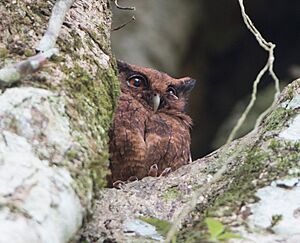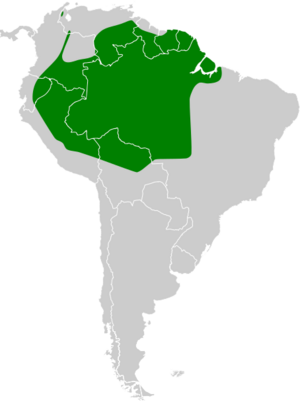Tawny-bellied screech owl facts for kids
Quick facts for kids Tawny-bellied screech owl |
|
|---|---|
 |
|
| Conservation status | |
| Scientific classification | |
| Genus: |
Megascops
|
| Species: |
watsonii
|
 |
|
| Synonyms | |
|
Otus watsonii |
|
The tawny-bellied screech owl is a fascinating bird that hunts at night. It is a type of owl that lives in the warm, wet rainforests of South America. You can find this owl in many countries, including Bolivia, Brazil, Colombia, Ecuador, French Guiana, Guyana, Peru, Suriname, and Venezuela. Its scientific name is Megascops watsonii.
Contents
About the Tawny-bellied Screech Owl
Scientists group animals together to understand them better. The tawny-bellied screech owl was first described by an American scientist named John Cassin in 1849. Its scientific name helps us know exactly which owl we are talking about.
There are two main types, or subspecies, of the tawny-bellied screech owl. They are called M. w. watsonii and M. w. usta. These two types look a little different and live in slightly different areas.
What Does It Look Like?
The tawny-bellied screech owl is not a very big bird. It is about 19 to 24 centimeters (7.5 to 9.5 inches) long. That's about the size of a small ruler! It weighs between 114 to 155 grams (4 to 5.5 ounces), which is lighter than a can of soda.
This owl has a dark, yellowish-brown face with a thin, darker edge. It has dark yellow eyes with light-colored "eyebrows" above them. It also has long, wide "ear" tufts on its head, which are actually just feathers.
Its back and top of its head are dark gray-brown with black and light brown spots. Its tail has stripes of brown and light brown. The owl's chest is dark brown with small light spots. The rest of its belly is light brown with black stripes.
The M. w. usta subspecies looks similar but has more reddish-brown colors. Its eyes are a warm brown color. This subspecies can also be found in different color forms, like brown or light brown.
Where Does It Live?
The tawny-bellied screech owl lives in the lowland rainforests. It prefers older, untouched forests and also mature forests that have grown back after being cut down.
The M. w. watsonii subspecies lives north of the Amazon River. You can find it from eastern Colombia, across Venezuela and the Guianas, and south into Ecuador, northeastern Peru, and parts of Brazil.
The M. w. usta subspecies lives south of the Amazon River. It is found in eastern Peru, northern Bolivia, and southern Brazil. This type of owl can also live in forests near rivers and even close to human towns.
These owls usually stay in the lower parts of the forest, below 30 meters (100 feet) high. They are rarely found in areas higher than 600 to 700 meters (2,000 to 2,300 feet) above sea level.
Behavior and Life Cycle
Feeding Habits
We don't know a lot about what the tawny-bellied screech owl eats. It is a nocturnal animal, meaning it is active and hunts at night. It usually looks for food in the lower parts of the forest. Scientists believe it mainly eats insects, but it might also eat small animals.
Reproduction
Not much is known about how these owls reproduce. One time, a nest was found in a hole in a dead palm tree in September. It had a very young baby owl inside. Another nest was found with two eggs.
Vocalization
The main song of the M. w. watsonii owl is a long series of fast notes. These notes get quicker and louder, then fade away with a low trill sound. The song of the M. w. usta subspecies is similar but a bit slower.
The M. w. watsonii also has a second song, which is a short series of quick "wu" notes. The M. w. usta is thought to have a fast series of "bu" notes that slow down to a "bouncing" rhythm.
Conservation Status
The IUCN (International Union for Conservation of Nature) has listed the tawny-bellied screech owl as a species of "Least Concern." This means that, for now, it is not considered to be in danger of disappearing.
Even though it seems to be common and lives in many places, we don't know a lot about this owl. Since it needs mature forests to live, the biggest danger to its future is when its forest home is destroyed.


